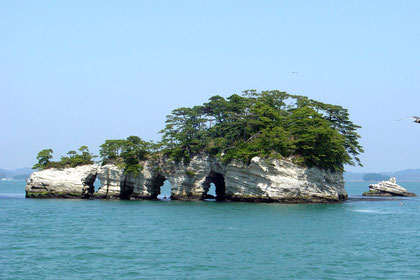Nihon Sankei

There are said to be three official “great views” in Japan, called the “Sankei” or “Nihon Sankei.” How these were selected and by whom remain a mystery, but one is near Sendai and another near Hiroshima, which were two places A. and I had been meaning to visit, and the third is near a town called Maizuru, which happens to be where I flubbed my second sales presentation. We got the contract anyway, thus garnering me an opportunity to rack up all three of the Sankei in one year.
Matsushima

During the Golden Week holiday in May, A. and I spent a few days in Sendai, which is about two hours north of Tokyo in the Tohoku region of Japan.
Entering Tohoku was like crossing an invisible barrier, with the temperature dropping about 5 degrees between Tokyo and Sendai. Though A. complained about the cold from the moment we arrived, the bellhop at the hotel lauded our luck in catching such a burst of warm weather.
One month after we’d seen them in Kyoto, and weeks since they’d disappeared from Shizuoka, the cherry blossoms were still blooming.
The area around Sendai station was like a monument to department stores, all interconnected by raised walkways as wide as two-lane streets below which floated a literal ocean of taxis, wave after wave breaking off from the front while fresh lines of reserves continually joined the rear.
The western end of Sendai, by contrast, is a city of trees and green, where Sendai Castle and the university are entwined by the Hirose River, which is not a broad and shallow spillway like most Japanese rivers, but a deep gorge bordered with gentle slopes covered in luscious greenery.
The first Sankei on our list was called Matsushima, which happened to be a very crowded 30-minute train ride north of Sendai.
Matsushima is a town living in symbiosis with its rocky landscape, where centuries-old caverns are now used to park cars and store old tires. The main temple, Zuigan-ji, is presaged by a lovely cedar forest and bounded on three sides by sheer rock face, into which are carved an elaborate series of mossy rooms and chambers. We found that the temple itself had been recently refurbished with gold leaf, with every interior wall gleaming in the afternoon sun.
The “great view,” however, actually comprises the countless islands of Matsushima Bay, which are formed of sedimentary rock—rather rare in volcanic Japan—that has been washed away into unique shapes and patterns, much like the islands of Georgian Bay on Lake Huron. The area is also a major oyster fishery, which explains where the sediment came from. Half of the beaches are still made of recognizable oyster shells.
A 2000-yen boat tour took us around the islands, while we were intermittently pursued by a flock of seagulls snagging salted snacks from tourists’ outstretched hands. The islands themselves were innumerable and lovely, but I suspected that they might have been more impressive if discovered one by one on a little sailboat rather than all in a glut from a mechanically gliding ferry.
That, and the 3x Optical Zoom on my Cyber-Shot camera just wasn’t up to snuff.
Amanohashidate
The next of the Sankei was managed as a side-trip while I was in Maizuru checking on new ALTs in June.
Maizuru is a port town on the far side of Kyoto, and it’s about an hour from Amanohashidate (don’t give up: Ama-no ha-shi da-teh), a 3.5-kilometre sandspit that cuts across Miyazu Bay on the Sea of Japan. The crossing offered a choice between senescent pine-covered walk or white sandy beach, and on the far side a cable-car took us to the top of a hill overlooking the bay, from whence we could see the entirety of the “Bridge to Heaven,” as the name literally translates.
To achieve the appropriate effect, you have to put your head between your legs and look at the sandspit upside-down. Little pedestals are even provided for easy viewing. From this position, you can (a) have your friends take a silly picture of you looking out your ass, and (b) wait for the blood to settle in your temples as you start to think the bay is the sky and the sky is the bay, at which point it really does look like a meandering green road into heaven.
Miyajima
The last of the Sankei was also the most famous: the floating red torii gate at Miyajima. This is a brief ferry-ride away from Hiroshima, and we took one of the very big Hiroshima streetcars down to the ferry dock, where we got on the ferry right at sunset.
The island shrine (actually called Itsukishima-jinja) was traditionally approachable only by water since the island was too holy to be trod upon by commoners, thus requiring the “floating” gate out in the water. However, the gate is only surrounded by water when the tide comes in, so we were sure to arrive in the evening to avoid taking photos of a red gate on a field of mud.
The gate was indeed picturesque, particularly cast in silhouette against the setting sun, and when it got dark it was illuminated with a vibrant glow. There were an assortment of hiking trails leading into the hills, but we arrived too late to take advantage of these, and instead wandered around the narrow, stratified streets of the surrounding village, spotting stray cats and wandering tanuki while avoiding the aggressive deer, which would stick their heads in trash cans and chew on unwary tourists’ shirts of their own accord.











